Unit 10 Connections Viewing Workshop课件(共17张,内嵌视频) 2024-2025学年高二英语北师版(2019)选择性必修4
文档属性
| 名称 | Unit 10 Connections Viewing Workshop课件(共17张,内嵌视频) 2024-2025学年高二英语北师版(2019)选择性必修4 | 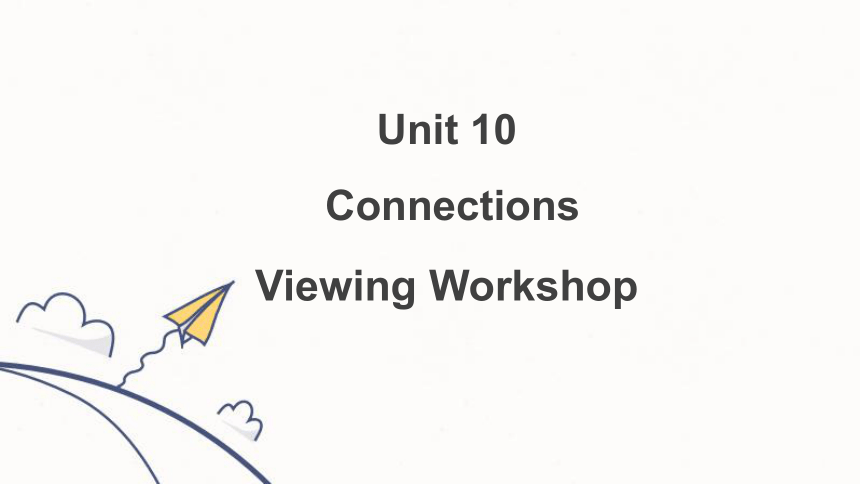 | |
| 格式 | pptx | ||
| 文件大小 | 57.4MB | ||
| 资源类型 | 教案 | ||
| 版本资源 | 北师大版(2019) | ||
| 科目 | 英语 | ||
| 更新时间 | 2025-04-29 18:21:02 | ||
图片预览


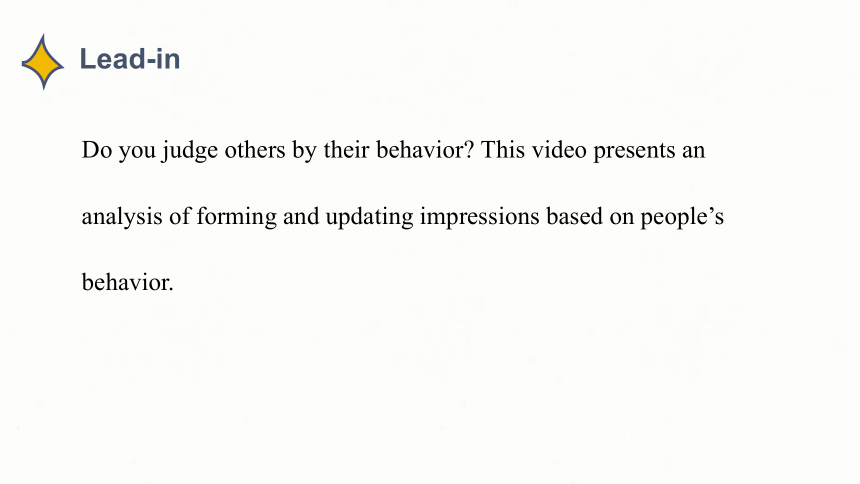
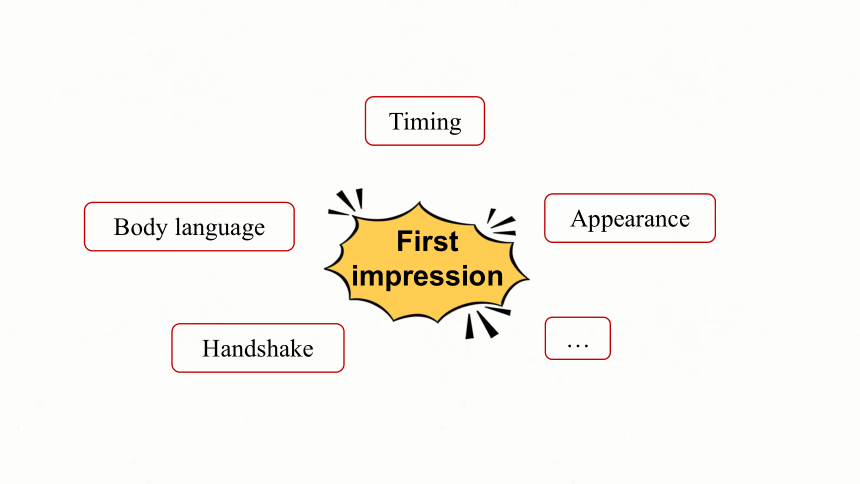
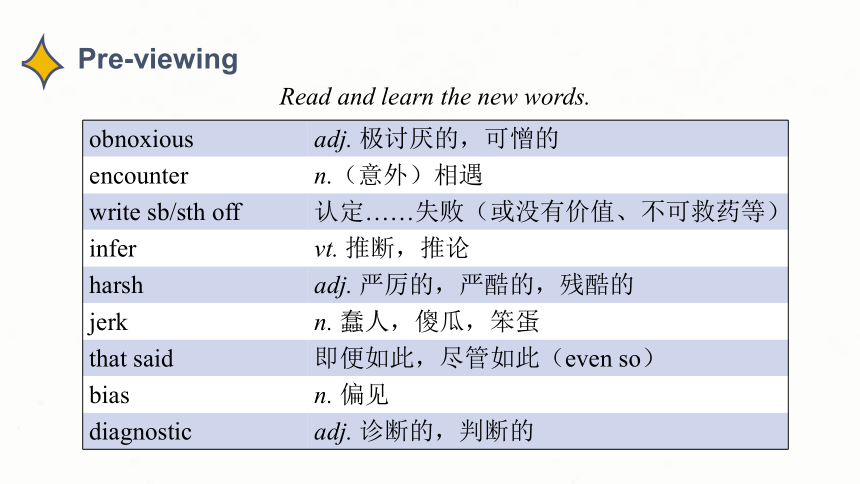
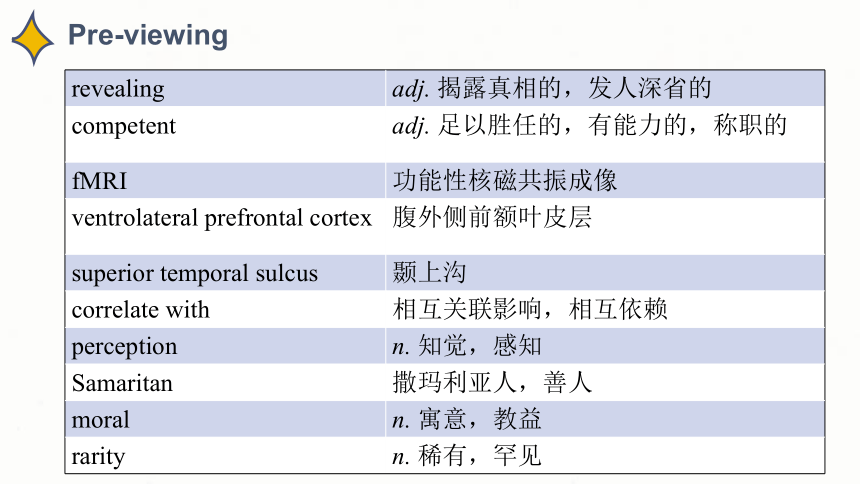

文档简介
Unit 10
Connections
Viewing Workshop
To watch and talk about first impressions.
To watch a video for understanding.
To express your opinion on how first impressions are formed.
Learning objectives
Do you judge others by their behavior? This video presents an analysis of forming and updating impressions based on people’s behavior.
Lead-in
First impression
Timing
Appearance
Handshake
Body language
…
{5C22544A-7EE6-4342-B048-85BDC9FD1C3A}obnoxious
adj. 极讨厌的,可憎的
encounter
n.(意外)相遇
write sb/sth off
认定……失败(或没有价值、不可救药等)
infer
vt. 推断,推论
harsh
adj. 严厉的,严酷的,残酷的
jerk
n. 蠢人,傻瓜,笨蛋
that said
即便如此,尽管如此(even so)
bias
n. 偏见
diagnostic
adj. 诊断的,判断的
Read and learn the new words.
Pre-viewing
{5C22544A-7EE6-4342-B048-85BDC9FD1C3A}revealing
adj. 揭露真相的,发人深省的
competent
adj. 足以胜任的,有能力的,称职的
fMRI
功能性核磁共振成像
ventrolateral prefrontal cortex
腹外侧前额叶皮层
superior temporal sulcus
颞上沟
correlate with
相互关联影响,相互依赖
perception
n. 知觉,感知
Samaritan
撒玛利亚人,善人
moral
n. 寓意,教益
rarity
n. 稀有,罕见
Pre-viewing
1. What might be your first impression of this man?
2. Do you change your impression of him after the second encounter?
Think about the following scenes and answer the questions.
Imagine you went to see a football game. The man sitting next to you was loud, spilt his drink on you, and made fun of your team. Days later, you’re walking in the park when it starts to rain. The same man from the football game shows up at your side to offer you an umbrella.
Pre-viewing
We’re quick to form lasting first impressions of others based on their behaviours.
We form impressions of others with little effort and from a single behaviour.
We cannot change our impressions in light of new information.
Read the following sentences and predict whether they are true.
While-viewing
Watch Part 1 of the video. Write T or F according to the speaker.
While-viewing
We’re quick to form lasting first impressions of others based on their behaviours.
We form impressions of others with little effort and from a single behaviour.
We cannot change our impressions in light of new information.
T
T
F
While-viewing
Watch Part 2 of the video. Complete the information.
1. Very negative, highly immoral information has a ______________ than very positive, highly moral information.
2. When learning about another person’s abilities and competences, the __________________ gets weighed more heavily.
3. Highly immoral actions and highly competent actions are ___________ behaviors that people tend to weigh ____________.
stronger impact
positive information
less frequent
more heavily
While-viewing
4. The brain decides whether the behavior is typical or
________________ in order to make complex decisions.
5. Caring more about the very negative, immoral things is ____________ of the comparative rarity of those bad behavior. “Bad” might be stronger than “good”, only because “good” is _____________.
out of the ordinary
a direct result
more plentiful
While-viewing
According to the speaker, in forming or updating impressions of a person, people often make their decisions not simply by judging whether he/she had done something negative or immoral, but by whether that behaviour is comparatively less frequent.
Do you agree? Why?
Think about the speaker’s viewpoint and share your opinion.
Post-viewing
How to make the perfect first impression?
Knowing how judgments work can give you a better sense of what kind of one you’re making.
In a very short time, the other person forms an opinion about you based on your appearance, your body language, your manners, your special habit, and how you are dressed.
Speaking
Be on time.
Be yourself, be at ease.
Present yourself properly.
A winning smile.
It’s important to know how to create a good first impression, and the following tips may help you to do it successfully.
Speaking
Think about the last time you judged someone based on their behavior, especially a time when you really feel like you changed your mind about someone. Write about it in 100 words.
Homework
Connections
Viewing Workshop
To watch and talk about first impressions.
To watch a video for understanding.
To express your opinion on how first impressions are formed.
Learning objectives
Do you judge others by their behavior? This video presents an analysis of forming and updating impressions based on people’s behavior.
Lead-in
First impression
Timing
Appearance
Handshake
Body language
…
{5C22544A-7EE6-4342-B048-85BDC9FD1C3A}obnoxious
adj. 极讨厌的,可憎的
encounter
n.(意外)相遇
write sb/sth off
认定……失败(或没有价值、不可救药等)
infer
vt. 推断,推论
harsh
adj. 严厉的,严酷的,残酷的
jerk
n. 蠢人,傻瓜,笨蛋
that said
即便如此,尽管如此(even so)
bias
n. 偏见
diagnostic
adj. 诊断的,判断的
Read and learn the new words.
Pre-viewing
{5C22544A-7EE6-4342-B048-85BDC9FD1C3A}revealing
adj. 揭露真相的,发人深省的
competent
adj. 足以胜任的,有能力的,称职的
fMRI
功能性核磁共振成像
ventrolateral prefrontal cortex
腹外侧前额叶皮层
superior temporal sulcus
颞上沟
correlate with
相互关联影响,相互依赖
perception
n. 知觉,感知
Samaritan
撒玛利亚人,善人
moral
n. 寓意,教益
rarity
n. 稀有,罕见
Pre-viewing
1. What might be your first impression of this man?
2. Do you change your impression of him after the second encounter?
Think about the following scenes and answer the questions.
Imagine you went to see a football game. The man sitting next to you was loud, spilt his drink on you, and made fun of your team. Days later, you’re walking in the park when it starts to rain. The same man from the football game shows up at your side to offer you an umbrella.
Pre-viewing
We’re quick to form lasting first impressions of others based on their behaviours.
We form impressions of others with little effort and from a single behaviour.
We cannot change our impressions in light of new information.
Read the following sentences and predict whether they are true.
While-viewing
Watch Part 1 of the video. Write T or F according to the speaker.
While-viewing
We’re quick to form lasting first impressions of others based on their behaviours.
We form impressions of others with little effort and from a single behaviour.
We cannot change our impressions in light of new information.
T
T
F
While-viewing
Watch Part 2 of the video. Complete the information.
1. Very negative, highly immoral information has a ______________ than very positive, highly moral information.
2. When learning about another person’s abilities and competences, the __________________ gets weighed more heavily.
3. Highly immoral actions and highly competent actions are ___________ behaviors that people tend to weigh ____________.
stronger impact
positive information
less frequent
more heavily
While-viewing
4. The brain decides whether the behavior is typical or
________________ in order to make complex decisions.
5. Caring more about the very negative, immoral things is ____________ of the comparative rarity of those bad behavior. “Bad” might be stronger than “good”, only because “good” is _____________.
out of the ordinary
a direct result
more plentiful
While-viewing
According to the speaker, in forming or updating impressions of a person, people often make their decisions not simply by judging whether he/she had done something negative or immoral, but by whether that behaviour is comparatively less frequent.
Do you agree? Why?
Think about the speaker’s viewpoint and share your opinion.
Post-viewing
How to make the perfect first impression?
Knowing how judgments work can give you a better sense of what kind of one you’re making.
In a very short time, the other person forms an opinion about you based on your appearance, your body language, your manners, your special habit, and how you are dressed.
Speaking
Be on time.
Be yourself, be at ease.
Present yourself properly.
A winning smile.
It’s important to know how to create a good first impression, and the following tips may help you to do it successfully.
Speaking
Think about the last time you judged someone based on their behavior, especially a time when you really feel like you changed your mind about someone. Write about it in 100 words.
Homework
同课章节目录
- Unit 10 Connections
- Lesson 1 How Closely Connected Are We?
- Lesson 2 Community Spirit
- Lesson 3 Anne of Green Gables
- Unit 11 Conflict And Compromise
- Lesson 1 Living In a Community
- Lesson 2 Dealing with Conflict
- Lesson 3 War Memories
- Unit 12 Innovation
- Lesson 1 Scientific Breakthroughs
- Lesson 2 Aha Moment
- Lesson 3 Stephen Hawking
